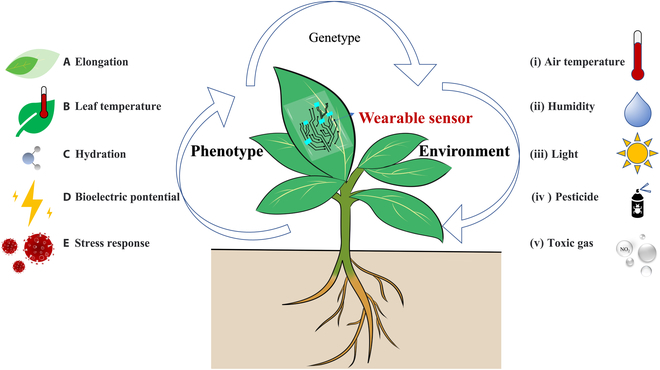Addressing the growing global need for food, it is crucial to enhance crop yields through effective phenotyping.

Wearable sensors for monitoring plant phenotypes and environment. Image Credit: TransSpread
Although optical imaging-based phenotyping has significantly advanced plant breeding and crop management, its noncontact approach poses limitations in spatial resolution and accuracy.
Wearable sensors, employing contact measurement, emerge as a promising alternative for on-site monitoring of plant phenotypes and their environment. Despite early successes in tracking plant growth and microclimate, the full potential of wearable sensors in plant phenotyping remains largely untapped.
Recent research published in Plant Phenomics aims to investigate the capabilities of wearable sensors in monitoring various plant and environmental factors, highlighting their high resolution, multifunctionality, and non-invasiveness while addressing challenges and proposing solutions.
Wearable sensors present a transformative approach to plant phenotyping, overcoming the limitations of traditional noncontact methods like optical imaging. They offer high spatial resolution, multifunctionality, and minimal invasiveness, allowing measurement of diverse plant phenotypes such as elongation, leaf temperature, hydration, bioelectric potential, and stress response.
Innovative features like stretchable strain sensors and flexible electrode sensors adapt to plant growth and morphology, facilitating real-time, in-situ monitoring. Unlike optical imaging, wearable sensors are less affected by environmental factors, providing more precise data.
For leaf temperature and hydration monitoring, wearable sensors utilize wireless communication and advanced materials for robust and accurate measurements. Advancements in bioelectric potential measurement are achieved through flexible electrode sensors that minimize plant damage and enable continuous monitoring.
Enhanced stress response detection is achieved through sensors monitoring early signs of diseases or environmental stress like UV radiation and ozone exposure.
Furthermore, wearable sensors excel in environmental monitoring, assessing factors such as air temperature, moisture, light, and pesticide presence. Multimodal sensors on lightweight, stretchable platforms gather real-time data crucial for understanding the microenvironment affecting plant growth.
While wearable sensors show great promise in plant phenotyping, they face challenges like interference with plant growth, weak bonding interfaces, limited signal types, and small monitoring coverage.
Proposed solutions include the use of lightweight, soft, stretchable, and transparent materials, advanced bonding technologies, and integration of diverse sensing modalities. As wearable sensor technology continues to evolve, it is anticipated to play a crucial role in expediting plant phenotyping and providing deeper insights into plant-environment interactions.
Journal Reference
Zhang, C., et al. (2023) Wearable Sensor: An Emerging Data Collection Tool for Plant Phenotyping. Plant Phenomics. doi.org/10.34133/plantphenomics.0051.